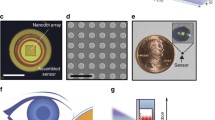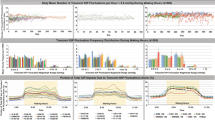Abstract
An important aspect of eye health in humans and animal models of human diseases is intraocular pressure (IOP). IOP is typically measured by hand with a tonometer, so data are sparse and sporadic and round-the-clock variations are not well characterized. Here we present a novel system for continuous wireless IOP and temperature measurement in small animals. The system consists of a cannula implanted in the anterior chamber of the eye connected to pressure sensing electronics that can be worn by rats or implanted in larger mammals. The system can record IOP with 0.3 mmHg accuracy and negligible drift at a rate of 0.25 Hz for 1–2 months on a regulated battery or indefinitely at rates up to 250 Hz via RF energy harvesting. Chronic recordings from conscious rats showed that IOP follows a diurnal rhythm, averaging 16.5 mmHg during the day and 21.7 mmHg at night, and that the IOP rhythm lags a diurnal rhythm in body temperature by 2.1 h. IOP and body temperature fluctuations were positively correlated from moment-to-moment as well. This technology allows researchers to monitor for the first time the precise IOP history of rat eyes, a popular model for glaucoma studies.







Similar content being viewed by others
References
Akaishi, T., N. Ishida, A. Shimazaki, H. Hara, and Y. Kuwayama. Continuous monitoring of circadian variations in intraocular pressure by telemetry system throughout a 12-week treatment with timolol maleate in rabbits. J. Ocul. Pharmacol. Therap. 21:436–444, 2005.
Asrani, S., R. Zeimer, J. Wilensky, D. Gieser, S. Vitale, and K. Lindenmuth. Large diurnal fluctuations in intraocular pressure are an independent risk factor in patients with glaucoma. J. Glaucoma. 9:134–142, 2000.
Bello, S. A., S. Malavade, and C. L. Passaglia. Development of a smart pump for monitoring and controlling intraocular pressure. Ann. Biomed. Eng. 2016. doi:10.1007/s10439-016-1735-y.
Bengtsson, B., M. C. Leske, L. Hyman, and A. Heijl. Fluctuation of intraocular pressure and glaucoma progression in the early manifest glaucoma trial. Ophthalmol. 114:205–209, 2007.
Collins, C. C. Miniature passive pressure transensor for implanting in the eye. IEEE Trans. Biomed. Eng. 14:74–83, 1967.
Cooper, R. L., D. Beale, and I. J. Constable. Passive radiotelemetry of intraocular pressure in vivo: calibration and validation of continual scleral guard-ring applanation transensors in the dog and rabbit. Invest. Ophthalmol. Vis Sci. 18:930–938, 1979.
Downs, J. C., C. F. Burgoyne, W. P. Seigfreid, J. F. Reynaud, N. G. Strouthidis, and V. Sallee. 24-hour IOP telemetry in the nonhuman primate: implant system performance and initial characterization of IOP at multiple timescales. Invest. Ophthalmol. Vis. Sci. 52:7365–7375, 2011.
Frampton, P., R. Da, and B. Brown. Diurnal variation of intraocular pressure and the overriding effects of sleep. Am. J. Optom. Physiol. Opt. 64:54–61, 1987.
Greene, M. E., and B. G. Gilman. Intraocular pressure measurement with instrumented contact lenses. Invest. Ophthalmol. 13:299–302, 1974.
Heijl, A., M. C. Leske, B. Bengtsson, L. Hyman, B. Bengtsson, and M. Hussein. Reduction of intraocular pressure and glaucoma progression: results from the Early Manifest Glaucoma Trial. Arch. Ophthalmol. 120:1268–1279, 2002.
Ho, J. S., A. J. Yeh, E. Neofytou, S. Kim, Y. Tanabe, B. Patlolla, R. E. Beygui, and A. S. Poon. Wireless power transfer to deep-tissue microimplants. Proc. Natl. Acad. Sci. 111:7974–7979, 2014.
IEEE. Standard for Safety Levels with Respect to Human Exposure to Radio Frequency Electromagnetic Fields, 3 kHz to 300 GHz. New York: IEEE, 1999.
Li, R., and J. H. Liu. Telemetric monitoring of 24 h intraocular pressure in conscious and freely moving C57BL/6J and CBA/CaJ mice. Mol. Vis. 14:745–749, 2008.
Liu, J. H., D. F. Kripke, M. D. Twa, R. E. Hoffman, S. L. Mansberger, K. M. Rex, C. A. Girkin, and R. N. Weinreb. Twenty-four-hour pattern of intraocular pressure in the aging population. Invest. Ophthalmol. Vis. Sci. 40:2912–2917, 1999.
Liu, J. H., X. Zhang, D. F. Kripke, and R. N. Weinreb. Twenty-four-hour intraocular pressure pattern associated with early glaucomatous changes. Invest. Ophthalmol. Vis. Sci. 44:1586–1590, 2003.
Mansouri, K., F. A. Medeiros, A. Tafreshi, and R. N. Weinreb. Continuous 24-hour monitoring of intraocular pressure patterns with a contact lens sensor: safety, tolerability, and reproducibility in patients with glaucoma. Arch. Ophthalmol. 130:1534–1539, 2012.
Mansouri, K., and T. Shaarawy. Continuous intraocular pressure monitoring with a wireless ocular telemetry sensor: initial clinical experience in patients with open angle glaucoma. Br. J. Ophthalmol. 95:627–629, 2011.
McLaren, J. W., R. F. Brubaker, and J. S. Fitzsimon. Continuous measurement of intraocular pressure in rabbits by telemetry. Invest. Ophthalmol. Vis. Sci. 37:966–975, 1996.
Melki, S., A. Todani, and G. Cherfan. An implantable intraocular pressure transducer: initial safety outcome. JAMA Ophthalmol. 132:1221–1225, 2014.
Montgomery, K. L., A. J. Yeh, J. S. Ho, V. Tsao, S. Mohan Iyer, L. Grosenick, E. A. Ferenczi, Y. Tanabe, K. Deisseroth, S. L. Delp, and A. S. Poon. Wirelessly powered, fully internal optogenetics for brain, spinal and peripheral circuits in mice. Nat. Methods. 12:969–974, 2015.
Moore, C. G., C. J. Elaine, and C. M. John. Circadian rhythm of intraocular pressure in the rat. Curr. Eye Res. 15:185–191, 1996.
RamRakhyani, A. K., S. Mirabbasi, and M. Chiao. Design and optimization of resonance-based efficient wireless power delivery systems for biomedical implants. IEEE Trans. Biomed. Circ. Sys. 5:48–63, 2011.
Refinetti, R., H. Ma, and E. Satinoff. Body temperature rhythms, cold tolerance, and fever in young and old rats of both genders. Exp. Gerontol. 25:533–543, 1990.
Leske M.C., Connell A.M., Wu S.Y., Hyman L.G and Schachat A.P. Risk factors for open-angle glaucoma: the Barbados Eye Study. Arch. Ophthalmol. 113:918–924, 1995.
Todani, A., I. Behlau, M. A. Fava, F. Cade, D. G. Cherfan, F. R. Zakka, F. A. Jakobiec, Y. Gao, C. H. Dohlman, and S. A. Melki. Intraocular pressure measurement by radio wave telemetry. Invest. Ophthalmol. Vis. Sci. 52:9573–9580, 2011.
Walter, P. Development of a completely encapsulated intraocular pressure sensor. Ophthalmic Res. 32:278–284, 1999.
Wang, G., W. Liu, M. Sivaprakasam, M. Zhou, J. D. Weiland, and M. S. Humayun. A dual band wireless power and data telemetry for retinal prosthesis. Conf. Proc. IEEE Eng. Med. Biol. Soc. 1:4392–4395, 2006.
Wentz, C. T., J. G. Bernstein, P. Monahan, A. Guerra, A. Rodriguez, and E. S. Boyden. A wirelessly powered and controlled device for optical neural control of freely-behaving animals. J. Neural Eng. 8:046021, 2011.
Wilensky, J. T. Diurnal variations in intraocular pressure. Trans. Am. Ophthalmol. Soc. 89:757–790, 1991.
Acknowledgments
The work was supported by NIH Grant R21 EY023376 and a Thomas R. Lee Award from BrightFocus Foundation. The authors thank Mr. Dan Capecci for assistance with wireless communication programs. The following intellectual interests are declared: U.S. Patents 9022968B2 and 9314375B1.
Author information
Authors and Affiliations
Corresponding author
Additional information
Associate Editor Tingrui Pan oversaw the review of this article.
Electronic supplementary material
Below is the link to the electronic supplementary material.
Rights and permissions
About this article
Cite this article
Bello, S.A., Passaglia, C.L. A Wireless Pressure Sensor for Continuous Monitoring of Intraocular Pressure in Conscious Animals. Ann Biomed Eng 45, 2592–2604 (2017). https://doi.org/10.1007/s10439-017-1896-3
Received:
Accepted:
Published:
Issue Date:
DOI: https://doi.org/10.1007/s10439-017-1896-3




